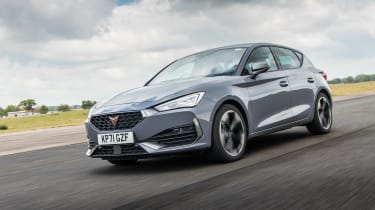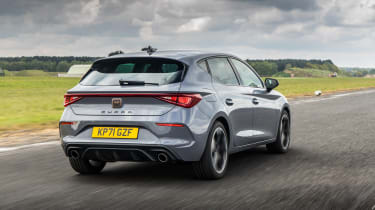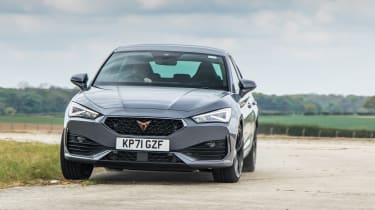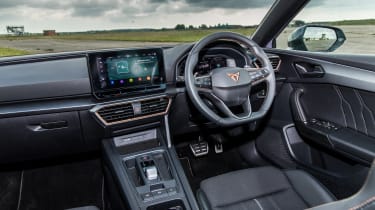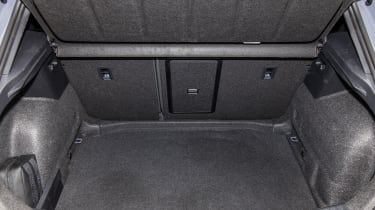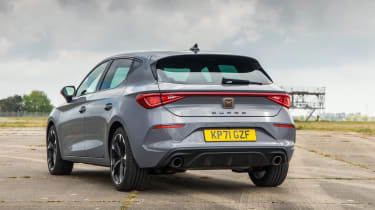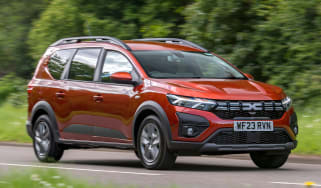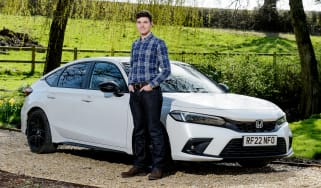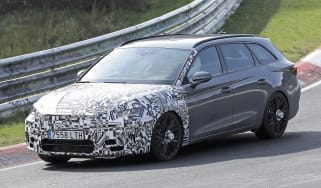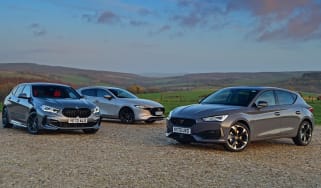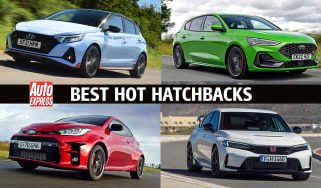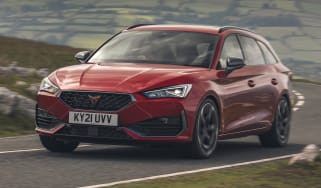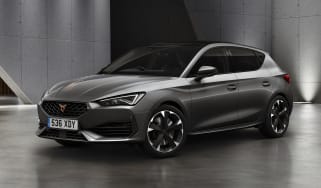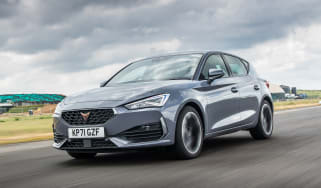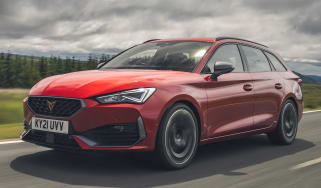Cupra Leon review
Now covering a wide range of options offering tepid to hot performance, there’s something for everyone in the Cupra Leon range

PCP finance available
The Cupra Leon was first launched as a seriously impressive hot hatchback, making fine use of the familiar 2.0-litre petrol TSI unit shared with the Volkswagen Golf GTI. It’s always managed to outshine the iconic German hatch for driving fun, while still providing all the expected practicality, refinement and day-to-day usability that buyers expect. More recently, a lower-powered version of that 2.0-litre engine plus an even less potent 1.5-litre four-pot has been added to the range, broadening the appeal of the model further.
If you can see past the peculiar branding, you’ll find a very well-crafted performance car that offers great value for money, while the availability of plug-in hybrid power and an estate bodystyle just adds to the appeal.
About the Cupra Leon
You may recognise the Cupra name as the performance moniker for various SEAT hot hatches over the past twenty years or so. What perhaps isn’t so widely known is that Cupra, since 2018, has been a standalone brand, creating its own bespoke models such as the Formentor SUV, alongside more powerful, sophisticated versions of current SEAT cars like the Cupra Ateca crossover.
The most recent entry in the range is the Cupra Leon hatchback, originally bred to take on the likes of the iconic Volkswagen Golf GTI and the supremely talented Honda Civic Type R, as well as performance models such as the Ford Focus ST, Skoda Octavia VRS and Hyundai i30 N.
More reviews
Car group tests
Long-term tests
Road tests
To begin with, power options for the Cupra Leon centred around the Volkswagen Group’s ubiquitous 2.0-litre, four-cylinder TSI unit, in either 242bhp or 296bhp form, with a 242bhp 1.4-litre petrol plug-in hybrid version to serve up an appealing combination of usable power and economy. Driving purists may be disappointed that there is no manual gearbox option available for any of these derivatives, with the hybrid and more powerful pure petrol cars using six- and seven-speed DSG automatic transmissions respectively.
Late in 2022, Cupra expanded the range to include a 187bhp version of the same 2.0-litre engine, plus a 148bhp 1.5-litre inline-four. The latter is the only Cupra Leon available with a manual gearbox. The new additions are significant, as unlike the pokier Cupra Leon powertrain options, which are Cupra-specific, these two are shared with the regular SEAT Leon. This provides an intriguing and possibly confusing choice for hatchback buyers.
Generous levels of standard kit will catch the eye of buyers looking for a good deal. The entry VZ1 trim (dubbed ‘V1’ for the two lowest-powered models, which can only be trimmed thusly) includes 18-inch alloy wheels, LED headlights, sports seats, sat-nav, a park assist function and a rear view camera. Moving up to VZ2 specification brings 19-inch alloys, speed-sensitive power steering and dynamic chassis control, while top-of-the-range VZ3 adds luxuries such as leather upholstery, heated front seats and a wireless smartphone charging pad.
The cheapest Cupra Leon, the 1.5-litre V1, is £29,515. This puts it in the ballpark of premium hatchbacks like the BMW 1 Series. Starting from £33,390, the 242bhp Cupra Leon undercuts its Golf GTI rival in automatic form by £4,370, which should provide food for thought when weighing up your hot hatch priorities, although if you need more space there is the estate version to consider. The wagon is offered with the lower-powered petrol engines, the plug-in hybrid powertrain or a 306bhp version of the 2.0-litre TSI engine with four-wheel drive.
Engines, performance and drive
Cupra has done a fine job engineering a little individual character into the hotter Leons. Yes, these versions are closely related to the Volkswagen Golf GTI, with all riding on the VW Group’s latest MQB platform, but the Leon has a longer wheelbase, the brakes are supplied by Brembo and the Spanish performance brand has spent time fettling the Leon’s suspension to create a particularly engaging hot hatchback.
The light variable-ratio steering still provides decent feedback and you’ll enjoy the Leon’s ability to push through tight corners with ease, willing you to get on the power as the differential does its job. Then there’s the straight-line speed - with next to no torque steer off the line, the 296bhp Leon is seriously quick and, overall, we found it to be a more complete car than its Volkswagen Golf GTI Clubsport rival - it’s that good.
You might think that all this performance comes at the expense of a comfortable ride, but not so with the Leon. There are 15 available damper settings, graded from the more forgiving Comfort, through to Sport and then the stiffer Cupra mode. We found adjusting the suspension nearer to Comfort meant that the Leon was no firmer riding than a standard SEAT model, while even cranking it up to the harshest position didn’t feel too jarring.
The lowest-powered models are - perhaps unsurprisingly - much less exciting to drive, although they do ride more firmly than some rivals, so you are still expected to make some comfort compromises.
0-62mph acceleration and top speed
The new entry-level 1.5-litre Leon offers brisk rather than truly fast acceleration, with its 148bhp output making for a 0-62mph time of 9.2 seconds when paired with a manual gearbox (8.9sec for the slightly more expensive dual-clutch automatic). The 187bhp 2.0-litre version is in more ‘warm hatch’ territory, dispatching the benchmark sprint in a respectable 7.2 seconds.
From here, the range gets much spicier. Even the 1.4-litre 242bhp e-Hybrid posts a 0-62mph time of 6.7 seconds. The plug-in version is 186kg heavier than the 2.0-litre 242bhp petrol car, although it benefits from an extra 30Nm of torque which helps its sprinting performance.
The pace increases with the 242bhp petrol version, which manages 0-62mph in 6.4 seconds and a 155mph maximum, while the top 296bhp variant trims this time to 5.7 seconds.
MPG, CO2 and running costs
The Leon range includes a 1.4-litre 242bhp plug-in petrol hybrid version offering potentially greater fuel efficiency and lower CO2 emissions than the other derivatives, depending on usage and how often it’s charged up. Cupra claims the e-Hybrid will provide an all-electric range of 32 miles from a single charge, while overall economy on the combined cycle stands at 217.3mpg. Business users will be particularly attracted by the e-Hybrid’s low CO2 figure of 30g/km.
Opting for the pure petrol-powered 2.0-litre TSI unit, with 242bhp, brings an obvious penalty to day-to-day running costs. In VZ2 trim it’s over £2,000 cheaper to buy than the e-Hybrid plug-in version, but fuel economy only reaches a maximum of 39.2mpg. CO2 emissions are higher at 162-163g/km, and will bring a Benefit-in-Kind rate of 36 per cent for 2021/22 and 37 per cent for 2022/23. The lowest-powered 2.0-litre Cupra Leon isn’t much more frugal, managing 41.5mpg. The most efficient non-PHEV, the 1.5-litre TSI, is predictably far better, clocking a claimed 47.1mpg.
If you can afford the extra power of the 296bhp version, then you won’t find it much more expensive to run than either of the other 2.0-litre cars. It delivers 37.2mpg, with CO2 emissions of 171g/km, while insurance costs shouldn’t be much more expensive than the 242bhp variant (see below).
Insurance groups
The entry-level car sits in group 21 (or 22 when equipped with a DSG), which is about what we’d expect. The 187bhp 2.0-litre Leon meanwhile is in group 25.
Otherwise, insurance costs will be comparable with hot hatch rivals, with the Leon 242bhp petrol and plug-in versions sitting in group 28 - the same rating as the Volkswagen Golf GTI. The more powerful 296bhp variant is in group 30, while the VW GTI Clubsport (with the same power output) is in group 29. By way of further comparison, the 315bhp Honda Civic Type R will be more expensive to insure as it’s in group 38.
Depreciation
Residual values for the Cupra Leon look to be pretty average across the board. The 1.5-litre Leon holds onto the most of its original value with around 57 per cent retained after a typical three-year/36,000-mile ownership period, while for the 187bhp 2.0-litre car one rung up the ladder manages just under 53 per cent.
The 242bhp Cupra Leon manages a little better and about 54 per cent, similar to the plug-in hybrid version. The hot 296bhp derivative will hold onto around 53 per cent in its base trim, but in top-spec VZ3 trim it depreciates more than any other Cupra Leon hatch, being left with under 51 per cent. Off all versions, it’s the PHEV estate in the same trim that suffers the most, with under 49 per cent of its original value left after three years.
Interior, design and technology
While buyers have the choice of more extravagant hot hatchbacks such as the Honda Civic Type R with its huge rear wing and aggressive aero kit, the Cupra Leon offers a more subtle proposition. It features a bigger rear spoiler and sportier bumper design over the regular SEAT Leon which, along with its quad tailpipes on some versions, gives the Cupra a purposeful but still understated look. This aesthetic treatment is largely carried across all versions regardless of power output.
The Cupra brand has adopted copper-coloured detailing across all its models in an attempt to create an air of individuality, and it generally works quite well - particularly as an accent to the darker Magnetic or Graphene Grey paint colours. Other metallic exterior hues include Desire Red, Urban Silver, Midnight Black and Nevada White.
Standard kit is generous, with the VZ1 trim including 18-inch alloys, LED lights, sports seats, a digital driver display and a 10-inch touchscreen infotainment system with Apple CarPlay and Android Auto functionality. Bigger wheels, leather upholstery and heated seats are available as you upgrade through the VZ2 and VZ3, along with enhanced active safety systems.
Sat-nav, stereo and infotainment
With the Cupra Leon so closely related to the SEAT family, it’s not a surprise to discover that the layout of the infotainment system is familiar VW group fare, with screen response and loading times largely similar to that in a Golf. We prefer the Leon’s arrangement, though. In particular, the home screen is smartly laid out; there are three large, customisable tiles that are easy to select on the move.
However, the Leon suffers from poorly placed touch-sensitive heating controls below the main display, but does compensate for this with more prominent on-screen shortcuts for both the climate functions and other menu keys. This includes the drive mode settings, which are accessed via a car-shaped icon at the bottom of the display – although the steering wheel-mounted button in our test car made things simpler still.
Practicality, comfort and boot space
The Cupra Leon is available as a five-door hatchback or in a more practical estate bodystyle, which means there is enough flexibility to carry passengers in good comfort, along with any luggage.
The entry VZ1 trim includes useful kit that makes ownership that bit easier - front and rear parking sensors are standard, along with a rear camera, power-folding mirrors and auto headlights, while inside there are two large cup-holders and big door bins for assorted oddments.
If you upgrade to the VZ3 specification then you’ll benefit from a wireless smartphone charging function, while useful options include a space saver spare wheel (instead of the standard repair kit) and an electric towing hook for the estate model.
Size
The Leon is 4,398mm in length, 1,799mm across (excluding mirrors) and stands 1,442mm tall, which makes it 111mm longer and 10mm wider than a Volkswagen Golf, although the Leon sits 49mm lower which adds to its sporty, more muscular appearance.
Leg room, head room & passenger space
Space upfront is good and headroom is on a par with the Volkswagen Golf. Rear legroom is actually better than you’ll find in the Golf, and taller passengers should have no problem getting comfortable behind the front two.
Boot space
With a 380-litre boot the Leon is just one litre down on the VW Golf’s load capacity, although it does trump the Ford Focus by five litres. The rear bench offers a 60/40 split and includes a ski hatch for carrying longer items, although there isn’t a variable height boot floor, so there is an awkward lip to negotiate when loading.
Reliability and safety
Cupra as a brand is too new to have featured in our Driver Power customer satisfaction survey, but if the performance of parent company SEAT (17th place out of 30 manufacturers) is anything to go by, it might well be found in the middle of the pack.
The SEAT Leon achieved a full five-star Euro NCAP rating for safety, with reassuring scores of 92 per cent for adult occupant safety and 88 per cent for child protection.
Standard safety equipment is good and includes a forward collision warning, a brake assist function, Lane Assist and a tiredness recognition system, along with features such as cruise control, front and rear parking sensors and auto rain-sensing wipers. The options list includes the Safety and Driving pack (£615) for the VZ2 and VZ3 versions - adding road sign information, High Beam Assist, predictive and adaptive cruise control, Side Assist and Exit Assist which provides a warning of approaching traffic when you open the door.
Warranty
Cupra offers a standard three-year/36,000-mile warranty, with the option to take out extended cover (at the time of purchasing a new model) for up to five years and 90,000 miles.
Servicing
Customers can take advantage of Cupra’s fixed-price servicing plans which allow you to pay for scheduled maintenance in monthly installments.
